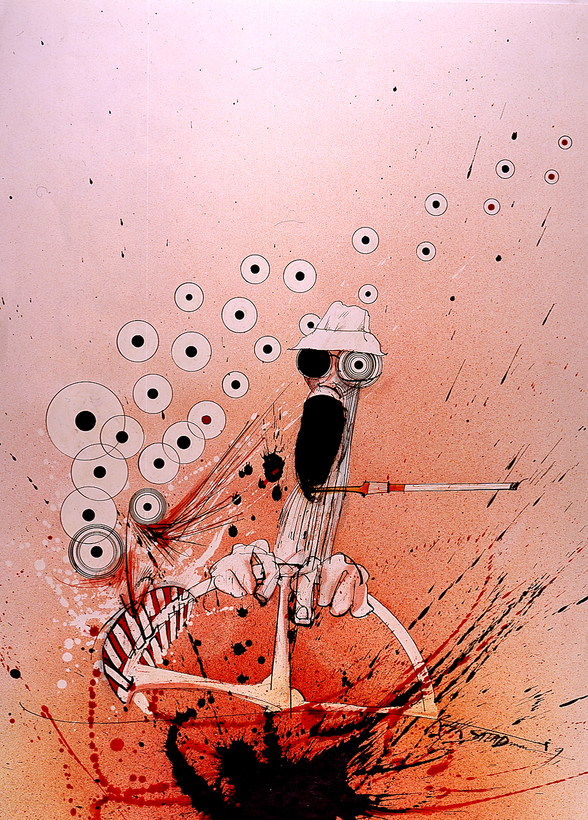Throughout most of Hunter S. Thompson’s career, illustrator Ralph Steadman rode shotgun on the bending antennae of the author’s ragtop ’70s Caddy. Whenever fresh perdition ensued, he transmitted it to ink on paper.
Now admirers and initiates can see 149 of his works in a retrospective that spans 60 years. After a run at the American University Museum, in Washington, D.C., which begins today, it will travel to other institutions around the country.

The Thompson-Steadman collaboration began in 1970, when they covered the Kentucky Derby for Scanlan’s Monthly. It ended with the writer’s self-imposed demise by Smith & Wesson at his Owl Farm compound, in Colorado, in 2005.
In between, Steadman and Thompson teamed up on scores of Rolling Stone articles and three books, most memorably Fear and Loathing in Las Vegas (1972), which became Thompson’s breakthrough moment, and Fear and Loathing on the Campaign Trail ’72. Both remain scathingly hilarious, unreliably narrated, drug-and-alcohol-fueled classics. “Gonzo” journalism, it was called.
One wonders if the books would have been such smashes if Steadman’s images hadn’t provided the trippy visual oomph. (Steadman didn’t even take drugs.) Born in 1936 in Wallasey, Steadman and his family fled the Blitz to North Wales. As a student, he was tormented by a headmaster “who liked to cane the boys,” says his daughter Sadie Williams, who co-curated the exhibition. “Dad spent most of his school years in terror. It was then that he decided authority is the mask of violence.”

Steadman loved building airplane models. His universe may have been shaped by hiding under classroom desks from air raids. As a young man, he apprenticed in technical design at the de Havilland Aircraft Company Limited. He also served in the Royal Air Force in the 50s as a radar operator. Later, studying graphic art in the 60s, he worked for publications such as Punch and Private Eye.
Steadman possessed a disciplined chaos. His ink-splattered images of reptiles, birds, and his own hollow-eyed hybrids were made in a style he described as “flick-of-the-wrist.” Perhaps one of his many portraits of Thompson—which depicted the author’s head as a desert cow skull with bat wings, wearing his Tilley T3 Snap Up bucket hat, circular Ray-Ban 3138 Shooter sunglasses, and a cigarette holder dangling with a Dunhill—is his Mona Lisa.

He rarely sold his work. “If anyone owns an original Steadman, it’s stolen,” he once said. Now aged 88 and living in Kent, U.K., the still-prolific artist is eager to see the new exhibition. Entitled “Ralph Steadman: And Another Thing,” it includes much of his work with Thompson and Rolling Stone, along with political caricatures, sketchbooks, ready-made-style Polaroids, correspondence, and other ephemera.
Even Steadman’s most devoted fans don’t know about his more formal canon, such as his covers and imagery for novels such as Alice in Wonderland, Animal Farm, Treasure Island, and Fahrenheit 451.
Steadman’s illustrations, including those for a biography of his hero, Leonardo da Vinci, are as recognizable as the works of Edward Gorey and R. Crumb. His British postage stamps commemorating the 1985 appearance of Halley’s Comet are collector’s items. The same goes for his album artwork for the Who’s 1966 single, “Happy Jack.” His more recent portrait of Bryan Cranston in Breaking Bad is indelible.

Viewers of this exhibition may leave with a new appreciation of Steadman’s artistic versatility. But ultimately, all roads lead back to Vegas. On his creative adventure with Thompson, he has said, “I was continually standing on the brink of annihilation and self-destruction, but never went over the edge.”
Steve Garbarino, the former editor at BlackBook magazine, began his career as a staff writer at The Times-Picayune. Once again New Orleans–based, he now contributes to The Wall Street Journal and New York and is the author of A Fitzgerald Companion
“Ralph Steadman: And Another Thing” runs from September 7 to December 8 at the American University Museum at the Katzen Art Center, in Washington, D.C. The exhibition will then travel to the Oklahoma State University Museum of Art, in Stillwater, Oklahoma (January 21–May 10, 2025); the Bates College Museum of Art, in Lewiston, Maine (June 6–October 10, 2025); and, later, the Barry Art Museum, at Old Dominion University, in Norfolk, Virginia. It will also tour the West Coast through the fall of 2027


